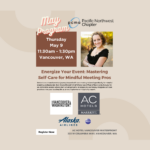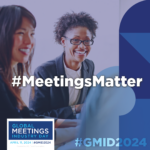Does anyone out there have Zoom fatigue like I do? Though it’s great to see faces, why am I left unfulfilled even seeing family and friends in this manner? Too many of these calls are viewed without seeing. Video calls are exhausting, especially if we’re on them for a long period of time. They require more focus than being face to face. Though we’re looking at the person, we’re viewing without perceiving. The definition of seeing is twofold: 1) to perceive with the eyes, and 2) to view, visit or attend as a spectator.
The eyes say it all. Singers and songwriters have been writing about the eyes throughout time. Perhaps you’ve heard the quote, “We try to hide our feelings, but we forget that our eyes speak.” On a video call, especially with multiple people, we must work harder to process the nonverbal cues, particularly from the eyes, which is even more difficult if our device is small and we struggle to see the detail surrounding the eyes of the other.
Maybe you’ve glanced at your image staring back at you and wondered if you should have some plastic surgery. The American Society of Plastic Surgeons claims chin augmentation increased 71% between 2011-2012, and facial procedures increased significantly in 2019, including a 49% increase in lip augmentation and 47% increase in cheek implants. Just how engaged are you in the convo when you’re thinking about that new wrinkle, or that your hair growth is causing you to look like a hippie from the 1960s? When everyone’s looking at you, there’s a social pressure that may make you feel like you need to perform, which may be nerve-wracking and stressful.
Video calls are also exhausting because we’re looking at a face or faces for long periods of time, requiring long spans of direct eye gaze. Long-term eye gaze is usually reserved for those intimately involved with us, not for our colleagues, acquaintances or strangers. As explained in a Wall Street Journal article (paywall), in a normal face-to-face work meeting, everyone is talking, writing or looking at notes, or even typing. Our time spent in mutual gaze, looking directly into the eyes of another, is brief and lasts only a few seconds. We get uncomfortable when we’re stared at for a long period of time.
The preferred length of eye contact is on average three seconds, as established by psychologists, and certainly not more than nine seconds. Dr. Zick Rubin found people engaged in discussion generally only make eye contact about 30-60% of the time.
Many of us think we’re great actors and actresses and don’t change our facial expression, keeping others from knowing what we really think of them or their ideas. But most of us are kidding ourselves because again, the eyes have it. Or don’t…if you’ve had Botox injections. A 2019 study in the Journal Emotion found it’s actually your wrinkles — the crow’s feet around your eyes — that show your sincere emotions of happiness, sadness and pain. Your sincerity — or lack thereof — is seen in a microsecond or less, in the constriction of your eyes.
A 2010 study in the Journal Emotion, found the supposed facial enhancer, Botox, to be a double-edged sword, robbing others of being able to read your emotions while conversely keeping you from reading their emotions. Botox interferes with our embodied cognition, the way facial feedback helps us perceive emotion. Both the injected and the listener find it harder to understand meaning or intention due to the removal of the crow’s feet, and it works both ways. Aging gracefully via Mother Nature allows you to be better understood.
The eye is the focal point of the face, and it’s part of a complex system of muscles and nerves that speaks much louder than words through the gaze and movement in the eyebrows, eyelids and temples. Blinking, too, conveys emotion. We blink a lot more for four reasons: when something angers, annoys or even surprises us; when we’re thinking about a lot of things simultaneously; when we start feeling nervous; and when we interact with someone we like.
Our eyes and glances transmit an incredible amount of social and emotional information and even information about others’ mental states. We make assumptions about personalities based on how much they meet our eyes or look away. When passing those who don’t make eye contact, we may be left feeling rejected.
Now of course there are different types of eye contact. Perhaps you’ve experienced being glared at, sneered at or even leered at? Piercing glares have started fistfights, and relationships can be damaged by insisting on eye contact. You know this if anyone has ever demanded of you, “Look me in the eyes when I’m talking to you!”
The brain is very perceptive to faces and eyes. Eyes tell you if a smile is real, for it takes completely different muscles to smile for real than when forcing a fake smile. Smile authenticity cannot be faked. Perhaps you want to be remembered for what you say and do? Then make positive eye contact.
Eye gazing releases the bonding chemical oxytocin and cultivates love and trust. Beyond video calls, perhaps pandemic lockdown has led you to struggle in a relationship. Maybe you feel disconnected, annoyed, angered or lonely. You can change that in a mere two minutes. Research by Kellerman, Lewis and Laird found that the exchange of positive mutual, unbroken eye gaze for two minutes will increase feelings of passionate love…even with a stranger! Further, the left eye has been identified with the emotional center of the brain. Want to increase your connection in a relationship? Two minutes of gazing into their left eye, while resisting making silly faces or talking, and still blinking when needed, will create feelings of passion and vulnerability. If two minutes is too much, start with less — focus on truly seeing your partner.
Let’s start appreciating and using the eyes for their incredible power to help us connect.
Forbes Coaches Council is an invitation-only community for leading business and career coaches. Do I qualify?
Andrea Luoma
Andrea is a Transformational Catalyst & Principal at Accommõdāre Consulting. Read Andrea Luoma’s full executive profile here.…




